How close did the Germans come to Moscow in 1941 - myths and facts
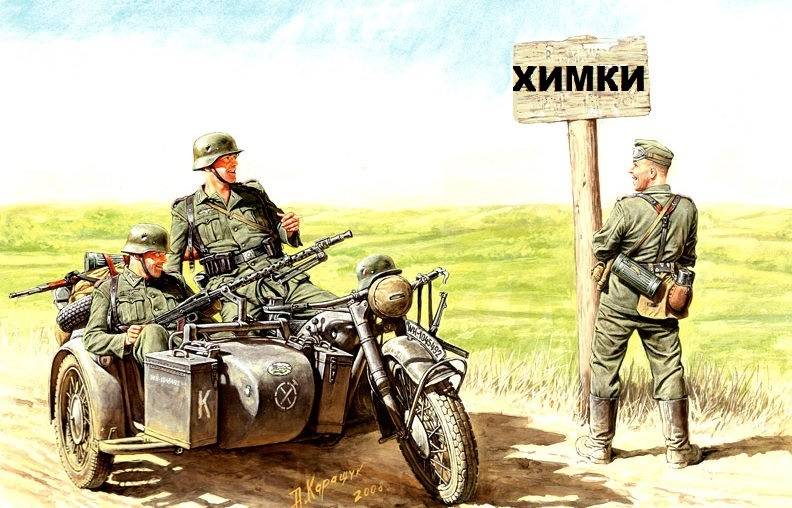
George Orwell. Remembering the war in Spain
About myths and myth-making
Any great event in stories mankind is always entangled in a dense layer of myths. This phenomenon is also characteristic of the Great Patriotic War, especially its initial period - the autumn of 1941.
The unifying feature of all myths is the obvious unusualness of the plot, which contributes to their wide distribution and extreme vitality.
Agree that few people are interested in listening and then retelling some ordinary things. But with stories that amaze with their improbability, the opposite is true: people listen to them with pleasure, remember them, and then tell their friends with no less pleasure, sometimes even embellishing an already quite picturesque plot.
If you suddenly want to get acquainted with the history of the city of Khimki near Moscow, then you will surely come across a description of an unusual event: on October 16, 1941, German motorcyclists suddenly appeared from somewhere on the bridge over the Khimki reservoir, followed (in some cases) even by a German armored personnel carrier.
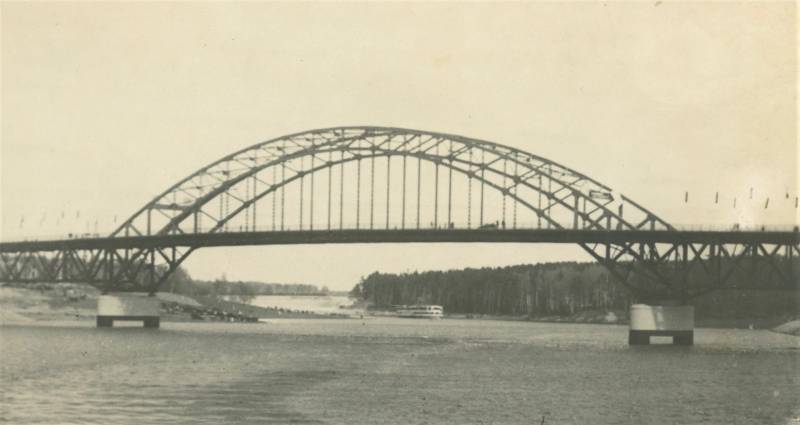
Bridge across the Khimki Reservoir: commissioned in November 1936, dismantled in early 1980
Further adventures of motorcyclists have several variations.
According to one version, they crossed the reservoir and boldly drove to the capital. But not far from the Okruzhnaya railway, they were met by the NKVD OMSBON detachment, driven to the territory of the Dynamo water station and destroyed there.
According to another version, the Nazis were lucky: they reached the station without hindrance. Sokol metro station, then for some reason they drove back, and then their traces were lost in the historical haze.
The emergence of such an amazing story was the result of panic rumors that arose on 16.10.1941/XNUMX/XNUMX, when a mass evacuation of institutions and enterprises began in the capital, the subway closed, and in some places even riots began to arise - distraught crowds smashed grocery stores. The emotional state of the people reached its peak, and rumors quickly began to spread in the city that allegedly advanced German units were already entering the suburbs of Moscow - Khimki and Tushino.
It would seem that after the end of the war, when the information vacuum about the events of October 1941 began to gradually fill up, the rumors about the appearance of the Germans in Khimki should have been completely and irrevocably dispelled.
But it was not so, myths do not give up so easily. At the end of the 60s, the exciting story about the breakthrough of German motorcyclists was again launched into the masses - this time Soviet newspapers distinguished themselves.
One of the first publications about the mythical coming of the Germans to Khimki appeared on July 14, 1968 in the press organ of the Moscow industrial and rural regional committees of the CPSU, the Leninskoe Znamya newspaper. Then, in 1971, in the newspapers Vechernyaya Moskva and Moskovsky Komsomolets, articles “The Battle on the Khimki Bridge” were published, retelling information from the publication of Lenin's Banner. They stated that on October 16, 1941, “significant battle» Soviet tanks (numbering about 10) with German motorcyclists on the Khimki bridge.
As a result, the myth of the coming of the Germans to Khimki again went to the people.
Residents and party activists of Khimki, who were in the city during the war years, were greatly surprised by these publications - they had not heard anything about such an event. And the former first secretary of the Khimki City Party Committee, A. A. Dymov (who served in this position in 1941), outraged by what he had read, even published an article in the Military History Journal (No. 5, 1972), where he called such publications fictions composed in pursuit sensations. Dymov assured that not only the residents and party workers of Khimki heard nothing about the appearance of the Germans in Khimki during the war years, the Moscow Committee of the Party, as well as the headquarters of the Moscow Defense Zone, did not know anything about it either.
One of the conclusions of the article is categorical:
Comrade Dymov categorically rejected the possibility of a German breakthrough into Khimki in the following months - there was no such information either.
But, as you know, the power of the newspaper word can work wonders. It must be assumed that some Khimki residents who read the publications immediately began to recall that they seemed to have seen these wandering motorcyclists, or at least heard about them from eyewitnesses who can be trusted as themselves.
As a result, the myth generated by Soviet newspapers fell on fertile ground, and German motorcyclists continued their heroic raid not only in the domestic press (including the post-Soviet one), but also in the memoirs of some veterans.
And in the memoirs of the military intelligence officer Claudia Nikolaevna Miloradova (in her youth, she performed combat missions together with Zoya Kosmodemyanskaya), motorcyclists even transformed into a tank:
Rumors about the appearance of German tanks in Khimki are also mentioned by the British journalist A. Werth, who was in the capital in those October days (“Russia in the War of 1941-1945”):
The event cited in P. A. Sudoplatov’s book “Special Operations. Lubyanka and the Kremlin. 1930-1950":
It would seem that such famous people somehow should not repeat rumors. And Sudoplatov certainly could not be mistaken, because at that time he was in Moscow and was responsible for identifying and eliminating German sabotage groups - should he not know about all the DRGs identified in the capital, German landings and lost motorcyclists.
However, do not forget that memoirs are just a person's memories of the events of bygone days, designed in the form of a literary work. Therefore, there is no need to elevate them to the status of a historical chronograph, because usually they are replete with many inaccuracies, and also often contain descriptions of events in which the memoirist did not personally participate and learned about them from someone's retellings. Or he even read it in some post-war publications and then established himself in the opinion that he also remembers these events very well.
The above fragment from the book by P. A. Sudoplatov, which causes great bewilderment, can serve as confirmation of the correctness of this conclusion.
Firstly, there is no Moskva River near Sheremetyevo Airport, there is a part of the Canal named after. Moscow - Klyazma reservoir.
Secondly, there really is a bridge across the reservoir, which has long been called Khlebnikovsky, but there is no monument in the form of “nadolbs” next to the bridge (both old and new) and never has been.
It can be assumed that the memoirist had in mind the monument "Anti-tank hedgehogs" on the outskirts of Khimki near the exit from the bridge of the Leningrad highway. through the Oktyabrskaya railway, which is passed by people heading to the capital from Sheremetyevo Airport.
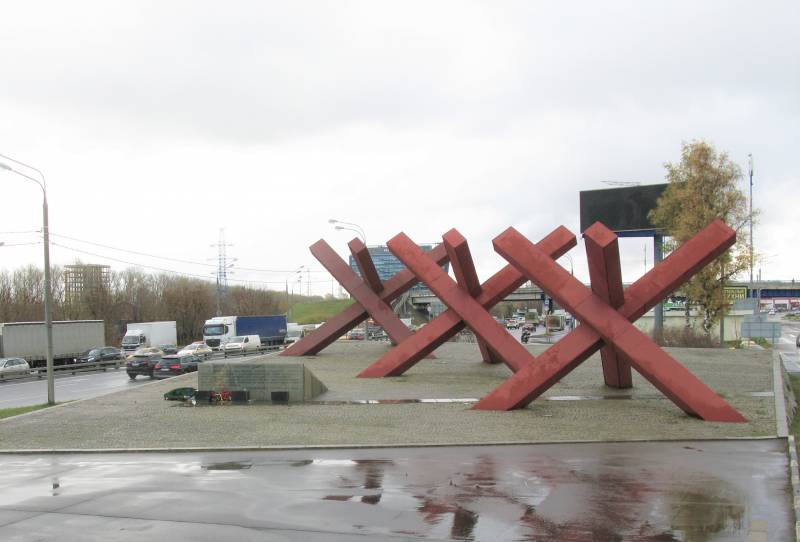
Monument in Khimki: opened on December 6, 1966 in memory of the beginning of the Soviet counter-offensive near Moscow in the winter of 1941.
Thus, there is a clear retelling of a greatly transformed rumor about German motorcyclists, most likely heard by Sudoplatov many decades after the end of the war. I believe that it was this fragment from the book of the legendary head of the reconnaissance and sabotage department of the NKVD that gave rise to the sometimes occurring myth that the Nazis in 1941 reached the northern outskirts of Khimki and were shot by an air defense crew, whose position was on the Leningrad Highway. next to the railroad bridge.
But could such a thing even theoretically happen?
Estimation of the probability of Germans appearing in Khimki
As the Russian historian D. I. Ilovaisky wittily remarked:
This conclusion is also true in relation to German motorcyclists - they do not fall from the sky either.
If the Nazis really appeared on the bridge over the Khimki reservoir near the village of Khimki on 16.10.41/XNUMX/XNUMX, then they did not fall from heaven, but came along the roads from some place where the fighting was going on. Therefore, the assessment of the probability of their appearance in Khimki comes down to an assessment of the probability of their movement along certain routes, originating from the places of the battles taking place that day.
Now it is necessary to remember that in the fall of 1941 the Germans launched an offensive with the aim of covering the city of Moscow. The advanced units were battle groups, including tanks and motorized infantry. In front of such a group, a reconnaissance patrol on motorcycles usually followed (sometimes accompanied by an armored personnel carrier). Consequently, if on 16.10.41/XNUMX/XNUMX German motorcyclists really appeared on the bridge, then it was reconnaissance of one of these battle groups, following in the head patrol at some distance (usually in the line of sight).
This means that it is possible to assess the likelihood of the Germans appearing in Khimki by familiarizing themselves with archival documents, which recorded the hostilities that took place on 16.10.41/XNUMX/XNUMX at a certain distance from Moscow.
According to the ZhBD ZapF, to the north-west of the capital, on that day, units of the spacecraft tried to dislodge the Germans from the city of Kalinin (now Tver). And if so, then in order to appear in Khimki, the German reconnaissance patrol had to (it is not clear why) drive along the Leningradskoe sh. about 150 km.
To the west of Moscow, the German units fought with units of 16 A and occupied the settlements of Ramenye, Rozhdestveno, Sereda - about 130 km from the nearest border of Moscow in a straight line. The appearance of the enemy from this direction is even less likely than their arrival from Kalinin.
Thus, it is absolutely indisputable that the probability of the Germans appearing in Khimki on 16.10.1941/XNUMX/XNUMX is zero.
Or maybe there was a little confusion, and the Germans appeared in Khimki not on October 16, but on November 16?
Let's try to estimate the probability of such an event.
On 16.11.1941/50/XNUMX, the German troops located in the Volokolamsky district, operating from the settlements of Shitkovo and Vasilyevskoye, launched a private offensive and captured the villages of Yadrovo, Mykanino, Rozhdestveno, Volokolamsky district. If they had moved along the Volokolamsk highway that day, they would have needed to travel more than XNUMX km to the Khimki bridge. But only they would be on it, following not from the region to the city, but vice versa - from the city towards the region.
In fact, the Germans did not even think of going to Moscow that day, since the private offensive was the first stage of the general offensive against Klin, which they captured only on November 23rd.
And the Germans, located in the Klin district, on 16.11.41/105/XNUMX fought in the vicinity of the village of Novo-Zavidovsky, also having the task of capturing Klin in the future. From there, it was about XNUMX km to Khimki along the Leningradskoye Highway, but they didn’t need to go to Khimki in those days.
Consequently, it is again absolutely indisputable that the probability of the Germans appearing in Khimki even on November 16, 1941 is also zero - on that day, the enemy did not need reconnaissance of the near approaches to the capital, and for a general idea of \uXNUMXb\uXNUMXbthe existing road network, the Germans were quite satisfied with the air reconnaissance data set on the highest technical level.
German fairy tales
Another myth about the coming of the Germans to Khimki was composed by the famous German storyteller (formerly a Nazi propagandist) Paul Schmidt (pseudonym Karel). In his book "Hitler Goes East" (published in 1963), when describing the events that took place on December 5, 1941, he gives the following information:
The same tale, with some heroic addition, was later cited in his book The Battle for Moscow by the extremely prolific German writer Werner Haupt:
The well-known Soviet international scientist G. L. Rozanov echoes the Germans in his book “Plan Barbarossa. Ideas and Finale (1970). Only he sends to Khimki "reconnaissance battalion of the 258th infantry division”, dating his appearance in the city on December 2.
These events are also fiction (which is substantiated in detail in the VIZh 1972 No. 5). From November 30, at the stations of Skhodnya, Khimki and Khovrino, the arrived troops were unloaded from the echelons and filled the area. And on December 2, the first counterattack of the 20th Army was carried out in the Krasnaya Polyana region. The nearest approaches to the capital were tightly blocked by the troops of the MZO, and the German offensive had already been suspended, and their gradual planned withdrawal from Moscow had even begun.
A small probability of the appearance of a German reconnaissance patrol in the vicinity of Khimki is only on the evening of November 30, when the Nazis occupied the village of Krasnaya Polyana and located just south of the village of Katyushki. This is the closest point from the positions of the Germans to the borders of Moscow in 1941 - about 17 km in a straight line.
Purely theoretically, on November 30.11.41, 30.11.41, individual motorcyclists could drive from the village of Katyushki on local primers to the village of Melkisarovo and even a little further to the Leningradskoe highway. However, this speculative construction does not find documentary confirmation. And the German group that occupied Krasnaya Polyana had the goal of moving further not at all to Khimki, but along the Rogachevskoye Highway. to Dmitrovsky sh. Consequently, on November XNUMX, XNUMX, German reconnaissance patrols were sent from Krasnaya Polyana along the Rogachev highway. to the east towards Eremino (which is confirmed by documents).
To the north-west of the city of Khimki, the last frontier, where the Red Army soldiers stopped the German troops rushing to Moscow in early December 1941, is the 40th km of the Leningrad Highway. - 17 km to the monument "Antitank Hedgehogs". In memory of this event, at an altitude of 217,1, near the turn to the city of Zelenograd, a large monument was erected, called "Bayonets":
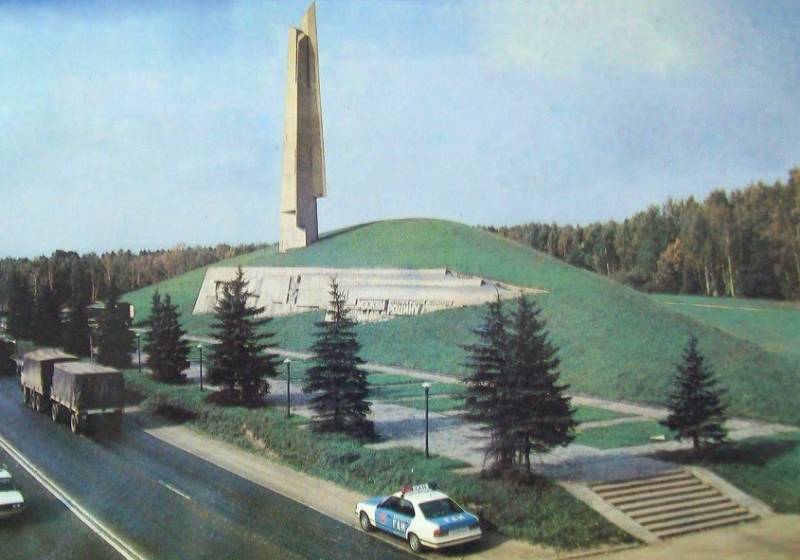
During the war years, German positions were located at this height, and the Red Army soldiers who blocked the highway near the village of Bol. Rzhavki tried several times to knock them out of there. After the retreat of the Germans, a large mass grave was arranged near the height, where, long after the war, the numerous remains of soldiers and spacecraft commanders found in this area of hostilities were buried. The exact number of dead warriors is unknown, of which only 23 have been identified ...
According to the administrative division of those years, this territory (including the village of Kryukovo, where there were also battles) was part of the Khimki district.
The possibility of a breakthrough of the German reconnaissance patrol from this direction is completely excluded: in those days, along the Leningradskoye sh. spacecraft equipment and troops moved in inexhaustible streams. And near the former village of Cherkizovo, it was crossed by a defensive line, from which a small section of an anti-tank ditch has survived to this day, located about 250 m to the right of the beginning of the exit from Leningradskoe to Sheremetevskoe sh.:
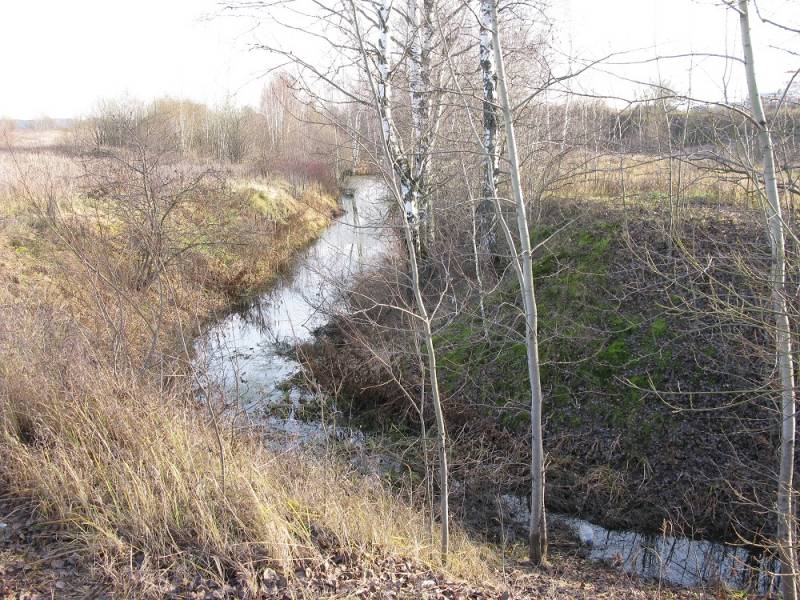
To the west of the city of Khimki, in early December, fighting took place in the village of Nefedyevo - about 21 km to the border of Moscow in those years in a straight line. Theoretically, the village roads available that year made it possible for German motorcyclists to go to Pyatnitskoye Highway, then follow it towards the capital, and then turn left and through the village of Korostovo reach the village of Kurkino, and from there get to the Khimki bridge.
However, the likelihood of such a journey of the Germans in those days is highly doubtful. Even if they managed to go to Pyatnitskoe sh. and go along it towards Moscow, then their voyage would end at Korostovo, where the headquarters of 16 A was located and there was its protection, whose task was to protect the commander of the 16 A K. K. Rokossovsky from the visits of such "travelers". Yes, and at Kurkino on the hillside in those days there was one of the barriers of the MZO, specially arranged to prevent such accidental passages of the enemy.
The battle groups of the Germans, moving along the Volokolamsk Highway, were stopped near the village of Lenino - about 26 km in a straight line to the border of Moscow.
The German troops advancing from other directions were stopped at a greater distance from the borders of the city.
As a result, we can conclude that the rumor about the coming of the Germans to Khimki turned out to be incredibly tenacious, and even found another repetition in the mouths of famous Russian historians on the TV show "The Way to Victory".
However, the totality of the currently published archival documents of the spacecraft units that participated in the Moscow battle allows us to state with a probability close to 100% that this colorful story is just one of the myths composed by people during that difficult period of World War II, and repeated after it.
Not a single document of the period 1941-1942, where this event would be reflected, has not been made public to this day. Colorful stories about the raid of brave German motorcyclists are based only on the personal memories of "eyewitnesses" and "direct participants".
As a result, it is worth noting that the defeat of the Nazi troops near Moscow in December 1941 is rightly called one of the main factors that led to their defeat in World War II. But there is also a less known fact: the likelihood of a second German offensive on the capital was considered relevant until 1943 inclusive. And the defensive positions on the outskirts of Moscow after the German retreat were not weakened, but, on the contrary, strengthened.
Information